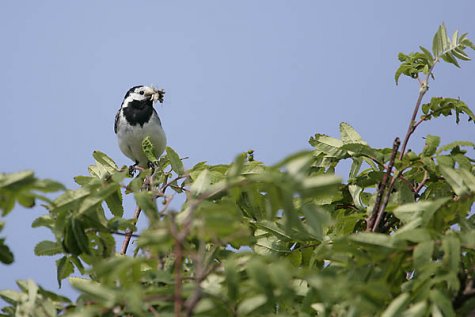Summer garden bird diary
Summary by Meelis Uustal
Photo: Arne Ader
Translation: Liis
Wagtail
Dear garden bird observer!
Many thanks for having found the time to note your garden bird observations nicely! As of today the inhabitants of nearly 300 gardens are observed already and the number of observers has passed 400. Already many interesting and surprising things have caught attention on browsing the entered information although nesting is only at half-term!
The summer garden bird diary is at:
At the end of June time is finally so far that a part of the garden birds already have a second clutch in the nest demanding food; for others the first chicks are only being hatched. Since the weekend promises both sun and rain it is a good opportunity to make a thorough tour of one’s garden and see if maybe some new bird pair has started nesting.
On Sunday however that tends to be rainy, I recommend looking through one’s garden bird diary observation data: can there be something that was not noted? Some hints that might be studied and checked in the garden and also in the diary.
- Starlings have finished their nesting – are all the nest noted?
- When starlings leave the nest box is often taken over by new tenants. Maybe swifts, tree sparrows or some other birds have come to nest in the starlings’ nestbox?
- House and tree sparrows, fieldfares and blackbirds, robins, chaffinches, yellow-hammers and wagtails, sometimes also great tits and blue tits nest twice during a summer. Their first nesting ended some time at the turn of May-June, the second nesting is now, for some however even at the end of July. They need however not all nest in the same place as on the first occasion. But have all nestings (also the unsuccessful) been noted?
- Review your list of birds that you have seen in your garden. Below I have listed the 25 most frequently met garden birds. Has any of these birds been seen but is not yet noted in the garden bird diary?
- On picking strawberries or mowing the grass you may meet frogs. The brown, rough-skinned toad is easily recognized. Brown, smooth-skinned frogs (common and moor frogs) must be caught to be identified – if the chest and throat are unicoloured and creamy we have to do with a moor frog. If there is a dark pattern then it is a common frog.
- In the Garden bird diary at the ”Üldinfo – General information“ tab there is a question about how many you were at observing the garden birds. Check if all garden bird friends have been noted.
- If you are not sure about the identification of a bird don’t hesitate to write to aed@eoy.ee. If you have a sound clip of the call of the bird (easy to make with a phone or a camera) or a photo (whatever quality) this certainly helps an identification.
As of now more than 170 bird species have been seen in the gardens. On average 20 species have been seen in one garden, at most a whole of 90 species. As nesters 62 species have been noted, but generally in a garden there are 10 times fewer bird pairs and species. In a couple of country homes exceptionally rich in birds more than 30 bird pairs and species nest. Nestbox birds most often nest in gardens: the starling as definite leader, followed far down by great tit, wagtail, tree sparrow and pied flycatcher. The most frequently encountered animals in the garden are toad, common frog, mole and common lizard, in fifth place is the European or brown hare. On average 4 animal species were encountered in a garden, but a couple of gardens happily had 11 and 15 species (true, frightening for some).
The 25 bird species that have been seen or heard most often in the garden are the following::
1) Wagtail
2) Great tit
3) Starling
4) Chaffinch
5) Blackbird
6) Robin
7) Greenfinch
8) Magpie
9) Cuckoo
10) Nightingale
11) Tree sparrow
12) Barn swallow
13) Blue tit
14) Hooded crow
15) Fieldfare
16) Swift
17) White stork
18) Crane
19) Pied flycatcher
20) Chiff-chaff
21) Wood pigeon
22) House sparrow
23) Mallard
24) Nuthatch
25) Goldfinch
Lasting enthusiasm and exciting moments in the nature of your garden!
Meelis Uustal, coordinator of the summer garden bird diary









